#rapeseed bug
Explore tagged Tumblr posts
Text





Фиалка трехцветная (Viola tricolor L.) и рапсовый клоп (Eurydema oleracea). Июнь 24. Tricolor violet and rapeseed bug. June 24.
#русский tumblr#россия#природа#лето#лес#цветы#Фиалка трехцветная#насекомое#рапсовый клоп#солнечныйдень#макрофото#мои фото#russia#nature#nature photography#summer#beauty of nature#sunny day#forest#flowers#Viola tricolor#Tricolor violet#flower photography#insects#rapeseed bug#flower aesthetic#my photos#original photography#photographers on tumblr#macro photography
254 notes
·
View notes
Text
Canola oil is not natural
Canola oil is not natural and is an invention of the food industry.
It is highly refined, highly processed and comes from the Rapeseed. Canola oil is the third most popular vegetable oil worldwide by volume, running just behind soybean and palm oil, because it's so cheap and effective as a food preservative. The reason why it's so effective as a preservative is because bugs won't eat it. In fact, plant-based canola oil is approved by the EPA for insect pest control. It kills flies, beetles and their larvae, caterpillars, stinkbugs, moths, mites, and mildew. What do you think it does to your body?
0 notes
Text
CROPS, POLLINATION, FOOD: WHY WE NEED BEES
33% of the world's yields need fertilization to set seeds and natural products, and a dominant part of them are pollinated by honey bees. Alongside different pollinators, honey bees are as of now endangered by human action. There is a worldwide decrease in the honey bee population, because of reasons like over the top utilization of bug sprays, living space misfortune, natural surroundings fracture, honey bee irritations and illnesses, and environmental change.
So as to bring issues to light about their basic job in supportable turn of events, the United Nations has proclaimed May 20 as World Bee Day.
There are almost 25,000 types of honey bees: 70-80% of the world's yields/plants are pollinated by wild honey bees while 15-20% are pollinated by honeybees. These pollinators additionally give a significant biological system administration that is basic for supporting the wild greenery biodiversity. For instance, if there should arise an occurrence of pigeonpea, Apis mellifera, A. dorsata, An indica (Pathak, 1970), Megachile spp. (Williams, 1977; Zeng-Hong et al. 2011), and Xylocopa spp. (Onim, 1981) are significant sources of normal cross-pollination.
Impact of honey bee fertilization on crop
It builds seed yield and natural product yield in numerous harvests.
It improves the nature of foods grown from the ground.
Honey bee pollination builds the oil substance of seeds in a sunflower.
Honey bee pollination is an unquestionable requirement in some self-incongruent yields for seed set.
Crops profited by honey bee pollination
Leafy foods, apple, apricot, peach, strawberry, citrus and litchi
Vegetable and Vegetable seed crops: Cabbage, cauliflower, carrot, coriander, cucumber, melon, onion, pumpkin, radish and turnip
Oilseed crops: Sunflower, niger, rapeseed, mustard, safflower, gingelly.
Search seed crops: Lucerne, clover
Developed field crops: Pigeonpea, lentils, clovers, Lucerne, mustard, assault, linseed, sesame, gingelly, buck-wheat, Cambodia, safflower, millet, and sunflower
Lumber trees: Neem, Cassia fistula, Acacia, Albizzia, Kachnar (Bauhinia purpurea), eucalyptus, sandalwood, raintree, wild cherry
Regular and decorative blossoms: Cosmos, shoe bloom, brilliant bar, cup and saucer, Tecoma stans, zinnia,
coral creeper (Antigonon leptopus), rose, Rangoon creeper, aster, wild rose (Kuja), hydrangea, violet, portulaca, poinsettia, honeysuckle, cornflower, coreopsis, dandelion and so forth.
What we should do:
Change to eco-accommodating pesticides
Limit intensive agriculture
Keep up normal natural surroundings inside a agriculture mosaic
1 note
·
View note
Photo
Also, that place REEKS like you wouldn't believe. People who don't live in the area where rapeseeds are grown on fields, you have no idea. The flower itself smells like a choking, dusty, faintly sweet air with something slightly rotten in there as well. Very grassy, very green, very "i feel like i am running out of oxigen also i think that someone sneaked a stinker fart in here".
BUT if you damage stalks by let's say squishing them with a blanket, the stench gets even more prominent. This thing smells like humid and sweaty heatwave. It stinks of rotting garbage can, slimy grass at the bottom of the dirty mower 3 days after cutting the grass, and icecream melted on the pavement. The air near those fields in bloom is hotter than the surface of the road and so so humid from all the plant respiration.
And the insect! The ground level is kept relatively shady so there is plenty of bugs of all kinds and since the whole thing is one bright yellow sea, the air is buzzing with bees and other polinators. You know of fruit flies and of sand flies, right? Well, whatever THESE flies are, they love hanging around these fields creating huge swarms flying around in big clusters, biting everything they land on and trying to crawl up your nose and mouth and ears. And because they are so damn tiny, you realize that they are around only once that invisible cloud enters your space. Good luck losing them, because they will more often than not follow you around.
The LAST thing you want to do is being anywhere near a place like is that one on the picture. And don't you dare wearing white!

Too funny
4K notes
·
View notes
Photo

🇫🇷 Petits phormiums deviendront grands… OU PAS ! Les deux spécimens que nous avons à l’arrière subissent une attaque de cochenilles farineuses… ☹️ J’ai tout traité avec une recette maison au savon noir/huile de colza trouvée sur le net donc je croise les doigts, mais si ça ne suffit pas, il faudra les remplacer l’année prochaine 🙃 Vous avez déjà testé une recette naturelle et efficace contre ces petites bêtes ? Bonne soirée ! • 🇬🇧 Small phormiums will become big... OR NOT! The two specimens we have in our back garden are suffering an attack of mealy bugs... ☹️ I treated everything with a homemade black soap/rapeseed oil recipe found on Internet so I'm keeping my fingers crossed, but if that's not enough, they'll have to be replaced next year 🙃 Have you ever tried a natural recipe that works against these nasty little beasts? Have a nice evening! • #newhouse #constructionmaison #maisonindividuelle #teamconstruction #maisonneuve #interior4all #deco #homedesign #homedecor #jardin #maisoncontemporaine #amenagementexterieur #gardentour #gardenview #homedesign #decorar #decoracão #decor #homedecor #phormium #palmtree #palmier https://www.instagram.com/p/ChAZoUFMR6u/?igshid=NGJjMDIxMWI=
#newhouse#constructionmaison#maisonindividuelle#teamconstruction#maisonneuve#interior4all#deco#homedesign#homedecor#jardin#maisoncontemporaine#amenagementexterieur#gardentour#gardenview#decorar#decoracão#decor#phormium#palmtree#palmier
0 notes
Text
Sesamol General Description
Sesamol is a natural organic compound which is a component of sesame oil. Sesamol has been found to be an antioxidant that may prevent the spoilage of oils, and may protect the body from damage from free radicals. It also may prevent the spoilage of oils by acting as an antifungal. Sesame oil is used in Ayurvedic medicine and sesamol may play a key role in this traditional field. Sesamol possesses a number of pharmacological properties which include anti-inflammatory, antioxidant, and neuroprotective properties. Sesamol pretreatment offers radioprotection and prevents radiation induced chromosomal aberrations in human blood lymphocytes.
Sesamol powder is crop that is grown for the oil in its seed. It is found in tropical and subtropical areas of Asia, Africa, and South America. Compared to similar crops, such as peanuts, soybean, and rapeseed, the seeds of sesame are believed to have the most oil. Sesame seeds are also rich sources of protein, vitamins, and antioxidants.
People take sesame by mouth for Alzheimer s disease, anemia, arthritis, heartdisease prevention, cataracts, constipation, high cholesterol, infertility in men, menopause, osteoporosis, pain, stomach ulcers, stomach cancer, stroke, and weight loss.
People apply sesame oil to the skin for aging skin, hair loss, anxiety, frostbite,psoriasis, warts, wound healing, pain, and to prevent bug bites.
People use sesame oil injections to improve the vocal cords.
In foods, sesame oil is used as cooking oil and to make dressings and sauces.Sesame seeds are added to food for flavoring.
Anna Yan [email protected] Whatsapp/skype:+86 186 2712 6189 http://www.whwingroup.com/
0 notes
Text
Biodiversity on our Terraces
I am excited about the diversity of the recent avian visitors to our high-rise terrace in Southbank. We live on level 5, not quite in the clouds, but overlooking a very busy and noisy intersection. We have a north-facing terrace of about 28 square metres and an east-facing one of 18 square metres, and our birds obviously love both of them.
Our northern open-air aviary has blossomed since we made a few adjustments to our garden. We are now almost enclosed, shielded from the outside with passionfruit vines all along the front and a healthy crop of leafy vegetables along the eastern side. Our full-height apartment windows form another side and a translucent glass wall finishes our almost-enclosure. Our eastern aviary is somewhat similar, walled in by dense vines, fruit trees and a host of green foliage bespeckled with flowers and vegetables.
Our front terrace is our main viewing area and we have replanted it recently with bird attracting shrubbery in mind. We planted quite a few particoloured flowering plants in the garden and have a tableful of pots with trailing leaves and flowers tumbling down almost to ground level. We have left some wilting leaves and other detritus on the ground to attract the insects and they have obviously attracted a few more birds.
Since my last post about our Currawongs, we have had repeat visits from one of them and have had several visits each day from a pair of adolescent Magpie-larks. A Little Raven has checked out our domain a few times. None of these have previously been regular visitors but our resident Sparrows, Doves and family of Mynas call in regularly every day. Our cloud of sparrows now spend more time on our smaller terrace, perhaps to avoid confrontation with the larger birds but they explore both areas when neither the Currawong nor the Raven is present. And to correct my previous record, as our Currawong has matured a little, we now believe it to be a Grey Currawong, rather than a Pied Currawong - and it certainly responds to the song of the Greys more than the Pieds’.
At any one time, we often have 4 or even 5 species present and we have delighted in their antics. We are usually only from 1 to 5 metres away from them with just a single pane of glass between us. They are well aware of our scrutiny, but obviously feel safe and confident unless we approach the open door.
The young Magpie-larks have spent a lot of time wandering around in the garden, selecting their lunch of insects from the flowers and other plants. They peck at many of our plants and appear to be eating some of the petals on the flowers as well - they certainly examine them closely and peck enthusiastically at them too. We often leave a few crumbs of toast out there and have experimented with a few other tasty morsels, greens and tiny pieces of fat or bacon rind, and the Magpie-larks have enjoyed both. I didn’t imagine they would go for the greens, but they have happily consumed our little offerings rather than destroying the foliage in out plantings.
The Raven, the Currawongs and the Mynas have also attacked the little pieces of protein with gusto, and the Doves, Sparrows, Mynas and Magpie-larks have enjoyed foraging for the tiny breadcrumbs we have left out. And we have watched the Currawong struggling with slightly larger tough crusts. He/she is very clever. He will toss the morsel around and if it is too crisp to swallow, he perches on the side of the birdbath and drops it in. He allows time for it to soak a little before retrieving it and consuming it with greater comfort.
(We usually leave a small amount of seed on our other terrace and both the Doves and Sparrows call us early each morning to provide them with a bit of brekky, but they are quite selective of which seeds they eat first from the current seed-mix we provide. The rapeseed is always left to last after everything else is consumed.)
All the birds except the Raven frequently use our little birdbath and we need to refill it several times a day when they splash vigorously and ruffle the water over the ground. We often see 2 or 3 birds in the birdbath at the same time and it is comical to see the Currawong in particular trying to bathe in the bath that is far too small for it. But we leave several different-sized water bowls around and all the birds visit several times a day to drink at, and bathe in, the bowl that most suits their respective sizes. The Sparrows often bathe in the smallest bowls if the birdbath is in use or too deep for them to use.
The Magpie-larks and Mynas in particular are very inquisitive and often approach close to the window and cock their heads while they peer inside at us. The Magpie-larks have actually poked their heads around the door jamb to check us out – perhaps we need to clean the windows more often to ensure they can see us without risking getting trapped inside. (We have had doves and sparrows inside on numerous occasions over the years and it stresses them until we can catch them or otherwise encourage to leave via the open door.) Occasionally, they give the windows a couple of desultory pecks, but without the insistence often displayed by mature male Magpie-larks (and others) who see their own reflection and imagine they are fighting off a rival.
The visits have often been quite extended, often 30 minutes or more, occasionally over an hour and all the birds have explored, and continue to explore, our plants for food – occasionally eating some of our greens, but regularly searching for bugs, beetles and other insects. They seem to see it as their secluded private playground and come and go quite freely, often exploring the same areas quite closely and making full use of the area as a food and drink source, a bathing area and simply a place to hang out with whatever birds are around when they drop in.
The fact that the area is largely enclosed probably gives them a sense of security without limiting their ability to fly in and out at any time. They seem to understand that we mean them no harm and they have certainly given us a great deal of entertainment and pleasure over the past couple of weeks in particular. There is no doubt in my mind that they believe that they have a relationship with us as just another (bigger) species - to be watchful about, but they investigate us with as much fascination as we are enthralled by them.
0 notes
Photo

7-Day Gut Healthy Meal Plan 😀 This plan is great if you're in gut health maintenance mode 👌🍽🌱 It combines unrefined grains like brown rice + quinoa, pules + legumes which contain prebiotics (food for our friendly gut bugs) + healthy fats like cold-pressed rapeseed oil. It may NOT be right for you if your gut is in a bad state right now, as you're better off removing grains + legumes, as they're harder to digest + can worsen inflammation. Head to homepage (link above👆) for clickable link to full article with recipes for each meal Thanks to BBC Good Food! http://bit.ly/2FJHABa #gut #guthealth #healthygut #guthealing #microbiome #weightloss #mentalhealth #autoimmune #gaps #gapsdiet #paleo #paleodiet #fodmap #glutenfree #whole30 #keto #ketogenic #ketodiet #detox #cleanse #clean #cleaneating #cleaneats #organic #organicfood #probiotics #wellness #recipe #recipes #recipeoftheday
#clean#guthealth#mentalhealth#microbiome#paleodiet#ketogenic#cleanse#organic#recipeoftheday#wellness#keto#glutenfree#autoimmune#organicfood#weightloss#gapsdiet#ketodiet#paleo#recipes#fodmap#healthygut#cleaneats#cleaneating#guthealing#gut#whole30#probiotics#recipe#gaps#detox
1 note
·
View note
Photo



Make your own Citronella essential oil (lemongrass)
You can’t go anywhere this year without tripping over citronella candles. There ability to repel mosquitoes and other pests is legendary but there is much more to this fantastic oil than just a bug repellent ( see my previous post).
To make the oil you will require:
Lemongrass
Rapeseed oil (or soy)
(For every 5gm of lemongrass you need 7.5ml of oil)
For example; two sticks weigh around 35g so I needed 50ml of oil.
Step 1 : finely cut the lemongrass
Step 2 : place it into the a glass bowl with the oil
Step 3 : using the end of a rolling pin or spoon gently pound the mix to form a paste
Step 4 : place the bowl into a large pan of gently simmering water for two hours
Step 5 : every 15 mins stir the mix and ensure all the bits are in the base of the bowl so they sit in the oil.
Step 6 : using a cheesecloth, muslin or coffee filter. Sieve the oil and store it in a dark coloured glass bottle.
Tip : the oil stores really well in the fridge.
Why not use the oil to make your own candles?
23 notes
·
View notes
Text
Aphids: species & different control methods

Aphids - they come from nowhere and can cause enormous damage to the beloved plants in the garden. Here is an overview of what species exist and how they can be combated.

The black bean louse - © hakoar - Fotolia.com Aphids are among the most well-known pests in their own garden. They infect ornamental as well as useful plants. They come quite surprisingly and in no time at all, they make mass on the young leaves and shoots of the plants to create. This pest infestation usually begins unnoticed, but then they expand explosively under optimal conditions.
In our climes native aphid species
About 850 species of these greedy insects are known in Central Europe. Some of them are among the most common representatives in our gardens. These include the ... Green peach aphid

© By Tsaag Valren - via Wikimedia Commons It occurs in two generations. The summer generation is colored green and has no wings. In the airworthy generations, the head and parts of the breast area are colored black-brown to black. The pest populates peach, plum and mirabelle, but also various vegetables and weeds. Black bean louse

© hakoar - Fotolia.com This insect forms several generations living in colonies. The winged and wingless maidens are broadly oval and dark green to dull black. Affected leaves curl up and the shoot tips twist. The louse spreads on beans , potatoes and turnips, but also on snowball and Pfaffenhütchen. Great rose aphid

© Eric - Fotolia.com The pest has a long spindle-shaped body with a black head. The body is green or pink. About as long as the body of the animal and usually a little longer, are the black feelers. The terrain of this aphid are roses , apple, pear and strawberry. Eriosoma Lanigerum

© commons.wikimedia.org The winged adult animals are dark brown to dark violet-stained. In addition, the body is covered by long, white, wool-like wax threads above the specimens living in the ground. The terrestrial blue-throated louse is littered with whitish-blue waxy particles. This lousy insect does damage to apple , pear and quince. Other aphid species that are at home in the garden are: the green apple aphidthe big plum tree aphidthe blackcurrant bubble lousethe oleander aphidthe Sitkalaus
The evil of the lousy plague
Aphids can do a considerable amount of damage to the garden, which can lead to crop losses, loss of quality and even complete crop failure. Because with their proboscis insects sting the plant cells still young, juicy leaves and shoots and suck out the sugary sap. But since they only need a small proportion of protein in their sap to live, they excrete some of the sugary juice again. As a result, the plant is partially covered with a sticky juice called honeydew. Fresh honeydew attracts other insects that feed on it. Especially ants are obsessed with this sugary excretion and milk the aphids. The ant defends the aphid even against attacks by beneficials. Wind and insects often colonize spores of fungal diseases on older honeydew deposits. However, the fungus does not cause much damage. Leave behind only unsightly dark mold spots. The airborne aphids raise but another problem. When colonizing new plants, these can become infected with viral diseases and these then spread, for example, on fruit trees or perennials.
Of course, prevent aphids
"Prevention is better than cure", this popular wisdom can also make use of the hobby gardener, if he wants to spare his plants in the garden an aphid plague. The best prevention against aphids is to cultivate the garden close to nature. In plain language this means: avoid larger accumulations of similar plantsCombine ornamental shrubs with different perennialsGrow vegetables in mixed cultureAvoid over-fertilization with nitrogen. Nitrogen continually stimulates the plant to produce juicy young shoots from which sap aphids benefit.Plant tree slices of fruit trees with nasturtium that keeps aphids away.
Lacewing, ladybird and co decimate aphids
Helpers in the protection against aphids are the beneficial insects. These are natural enemies of lousy malefactors. Of great benefit are: lacewingsladybugparasitic waspshoverfliesPredator bugs and other beneficial insects. Some of these useful helpers settle well in the garden. The fragrance of catnip infatuates the lacewing. The same attractant as this plant has, also exudes the aphid and attracts the fly. Ladybug keeps it in the garden when they find enough food. Thus, a small wildflower meadow with dill, yarrow , poppy and buckwheat may be an additional source of ladybirds aphid. In addition, it is advisable to build enough nesting possibilities in the garden, such as a small deadwood hedge, a lacewing box or an insect hotel . If the beneficials feel comfortable in your garden, then the aphid noticeably decreases after the first infestation in late spring or early summer. At the same time the aphid hunters multiply enormously due to the good food supply. Thus, in the course of the summer, a balance is established with which to live well. Home remedies can do wonders Before they resort to the commercial pesticides, probate home remedies are recommended. With a more manageable aphid infestation you can already achieve good results with Kernseife solution, nettle or tobacco. Beneficial plant protection The so-called Austriebsspritzung has proven successful in fruit trees in the spring, to prevent aphid infestation. When the buds become bulging and the first tips of the leaves are visible, the trees and shrubs are thoroughly treated with a Garden Safe Brand Multi-Purpose Garden Insect Killer such as promanal . Rapeseed oil, the active ingredient, penetrates into the tiniest crevices and covers aphids and wintering pests with a fine oil film, causing them to die. The plant protection against aphids should be beneficial in any case. After all, the hobby gardener does not want to disturb the natural balance of beneficial organisms and their nutritional needs in the garden. And so you can choose from the assortment of beneficial agent products in the garden shop. These preparations are based on rapeseed oil or potash soap. There are, for example, such products as "Ortho Flower, Fruit and Vegetable Insect Killer with Comfort Wand" or "Safer Brand 3 in1 Garden Spray Concentrate 32 Ounces" . These remedies clog the respiratory organs of the aphids, causing the insects to suffocate over time. To capture as many pests as possible, it is important that the plants are thoroughly sprayed from all sides. Read the full article
0 notes
Text
Juniper Publishers - Open Access Journal of Ecology
Population Trend of Grasshopper (Chortjippus Brunneus) and Cabbage Butter Fly (Pieris Brassicae) on Mustard (Brassica (Campestris L.)

Authored by : Muhammad Umer
Abstract
Present study was conducted on population dynamics of two insects Grasshopper (Chortjippus brunneus) and Cabbage Butterfly (Pieris brassicae) on mustard (Brassica campestris). The results of weekly mean population showed that the mean population of Pieris brassicae ranged from 0.0 to 1.4 in first week. Among the population maximum attack of caterpillar (1.4) was recorded in treatment 5; whereas no attack of caterpillar was recorded in treatment 1 (0.0). Second week the attack of caterpillar ranged from 0.3 to 3.0. Among the population maximum attack of caterpillar (3.0) was recorded in treatment 4; whereas the minimum attack of caterpillar was recorded in treatment 2 (0.3). Third week the attack of caterpillar ranged from 0.0 to 21.7. Among the population maximum attack of caterpillar (21.7) was recorded in treatment 1; whereas no attack of caterpillar was recorded in treatment 4 (0.0). Fourth week the attack of caterpillar ranged from 0.0 to 3.3. Among the population maximum attack of caterpillar (3.33) was recorded in treatment 3 whereas no attack of caterpillar was recorded in treatment 1 (0.0). While the mean population of grasshopper per plant ranged from 0.7 to 2.0 in first week. Among the population, maximum attack of grasshopper (2.0) was recorded in treatment 2; whereas the minimum attack of grasshopper was recorded in treatment 5 (0.7). Second week the attack of grasshopper ranged from 0.3 to 3.33. Among the population maximum attack of grasshopper (0.3) was recorded in treatment 3; whereas the minimum attack of grasshopper was recorded in treatment 4 (3.33). Third week the attack of grasshopper ranged from 0.3 to 3.0. Among the population maximum attack of grasshopper (0.3) was recorded in treatment 5; whereas the minimum attack of grasshopper was recorded in treatment 1 (3.0). Fourth week the attack of grasshopper ranged from 0.0 to 2.4 and so on whereas no attack of grasshopper was recorded in treatment 3, 4 and 7. Keywords: Population Trend; Grasshopper; Cabbage Butterfly; Mustard plant
IntroductionRapeseed commonly known as sarson belongs to the family crucifereae. Among different types, the most common grown in Pakistan are B. campestris, B. napus, B. juncea and Eruca sativa. In General, the rapeseed refers to B. campeastris and B. napus [1] The term rape is derived from the Latin word “rapen” means turnip. The rape seed is obtained from species of Brassica consisting of about 160 species. Many of them have economic importance and all parts of the plant contribute to their usefulness [2,3].The origin of rapeseed and mustard is not definitely known. Its cultivation has been traced to 2000 B.C in India, China and Ja-pan. Pak-Afghan region, Mediterranean region and the Turko-Ira-nain region are also its origin places. Brassica seed was first used for oil extraction in India [1]. According to Peolman & Borthakur [4] the origin of the different rapes and mustard has been reported as Asia, Europe and perhaps Africa. Rape and mustard are ex-tensively cultivated in Asia, Japan and Western Europe.Rapeseed and mustard are annual Rabi crops. It has a tap root system with many roots concentrate in the shallow surface soil and produce usually yellow flowers. Self-pollination is the rule in B. napus but B. campertris is both self and cross pollinated. The fruit is a pod, 5-10cm long. Each pod contains 15-40 small round seed of different colors, weighing 4-6 g per thousand seeds [1].According to Patel & Dee [5] B. campestris L. tends to a light-er, shorter and more erect growth habit than B. napus L. Its stem height varies considerably with variety from 50-200cm (with 80-150cm most common).
China is the largest producer of rape and mustard and to-gether with India and Pakistan they grow over 90 percent of the world production [4]. The average yield of this crop depends very much on climate and variety of the crop grown (Holmes, 1984). The highest yield is being obtained in the Netherlands, whereas the average is just over 2.6 tones/ha. While the average yield of rape seed and mustard in Pakistan based on the average of four years (i.e. from 1990-91 to 1993-94) is 745 kg/ha. The total production of rape and mustard in KP in the year 1993-94 was 14396.2 tones [6]. Weiss [7] stated that rape seed initial use was mainly to produce oil for industry and domestic lighting. Oil has been produced from oil seed rape and other brassica seed crops in Europe since at least the fifteen century and for a much longer pe-riod in Asia probably China [8]. Oil is now produced from rape in every continent [9]. Young leaves of rape and mustard are used as vegetable and as fodder. The oil is used in cooking and in making pickles and in industry as lubricant. Since the oil of conventional varieties contains high levels of erucic acid which is injurious to human health; cultivars have been evolved which are low in both erucic acid and glucosinulates which are designated as ’00’ types [1]. Jourges [10] mentioned that the averages percentage com-position of rape is oil (45%): protein (22%), carbohydrates (22-25%), Klason lingnin (5%), phytic acid (2%) and glucosinulates (1-4%). Pathak et al. [11] stated that the B. campestris L. Seed has 46.38% oil, 17.67% protein, 6.0% moisture, 3.74% ash and 0.46% allyl-iso-thiocyanate.Nazir [1] mentioned that the major insect pests of rape and mustard are the painted bug and aphids. Both the adults and nymphs of these insect’s suck cell sap from leaves, flowers and pods. Aphid control should be started when the nymph popula-tion reaches five per leaf. According to Gould [12]; like many other Brassica, rape falls prey to the infestation of a wide spectrum of insect, from the seedling stage to maturity damaging the crop and result in yield reduction. Srivastava et al. [13] stated that the aphid (L. erysimi) causes considerable damage not only to mustard but also to rape, tori and several other crop species. The incidence of the pest increases with the delayed sowing, while proper sowing time reduces the pest infestation.The pollen beetles, mustard sawfly, pea leaf miner, flea bee-tles, seed pod weevils, hairy caterpillar and cabbage butterfly are the most damaging insect pests of the rape crop. Majority of the pests infest the plant reproductive parts. The insects like pea leaf miners which attack the vegetative parts are less damaging and often more easily measurable [14].The present study was carried out to record the incidence and population density of Grasshopper (Chortjippus brunneus) and cabbage butter fly (Pieris brassicae) on mustard (Brassica camp-estris L.) crop.Materials and MethodsThis study was conducted to record the incidence of grasshop-per (Chortjippus brunneus) and cabbage butterfly (Pieris brassi-cae) on mustard crop at the Agricultural Research Institute Tarn-ab Peshawar, Pakistan in the year 2016 Rabi season.The mustard variety ‘Bulbul 98’ was raised on ridges in well prepared soil at Agriculture Research Institute Tarnab, during September 21, 2016. The experiment was conducted in RCBD with three replications and five treatments per replication. The length and width of each experimental unit was 5 and 3 me-ters, respectively. Each experimental unit was 3 meters apart from other.The direction of replications was East-West and treatment direction was North-South. Crop germinated on September 21, 2016. The field was visited regularly to the record population den-sity of the concerned insect pest Table 1
Data RecordingCommon insect pest of mustard crop is Grasshopper and cat-erpillar which attack on leaves. The data was collected on five randomly selected plants in each experimental unit and averaged over plant i.e. to present data as number of insects per plant. ResultsThe insect pests of mustard other than aphids were recorded from its time of germination till harvest. The mean population of Grasshopper and Caterpillar were recorded on at weekly interval as given in Tables.
Mean population trend of Grasshopper Chortjippus brunneusper mustard plant during October to December 2016 is given in Table 2.The mean population of grasshopper per plant ranged from 0.7 to 2.0 in first week. Among the population, maximum attack of grasshopper (2.0) was recorded in treatment 2; whereas the min-imum attack of grasshopper was recorded in treatment 5 (0.7). Second week the attack of grasshopper ranged from 0.3 to 3.33. Among the population maximum attack of grasshopper (0.3) was recorded in treatment 3; whereas the minimum attack of grass-hopper was recorded in treatment 4 (3.33). Third week the at-tack of grasshopper ranged from 0.3 to 3.0. Among the population maximum attack of grasshopper (0.3) was recorded in treatment 5; whereas the minimum attack of grasshopper was recorded in treatment 1 (3.0). Fourth week the attack of grasshopper ranged from 0.0 to 2.4. Among the population maximum attack of grass-hopper (2.4) was recorded in treatment 3; whereas no attack of grasshopper was recorded in treatment 4 (0.0). Fifth week the at-tack of grasshopper ranged from 0.3 to 2.3. Among the population maximum attack of grasshopper (2.3) was recorded in treatment 2; whereas no attack of grasshopper was recorded in treatment 4 (0.3). Sixth week the attack of grasshopper ranged from 0.6 to 2.3. Among the population maximum attack of grasshopper (2.3) was recorded in treatment 4; whereas no attack of grasshopper was recorded in treatment 3 (0.6). Seventh week no attack of grass-hopper was found on mustard crop. Eighth week the attack of grasshopper ranged from 0.0 to 1.3. Among the population max-imum attack of grasshopper (1.3) was recorded in treatment 3; whereas no attack of grasshopper was recorded in treatment 1 (0.0).
CaterpillarMean population trend of cabbage butterfly Pieris brassicaeper mustard plant during October to December 2016 ment 4; whereas the minimum attack of caterpillar was recorded in treatment 2 (0.3). Third week the attack of caterpillar ranged from 0.0 to 21.7. Among the population maximum attack of cat-erpillar (21.7) was recorded in treatment 1; whereas no attack of caterpillar was recorded in treatment 4 (0.0). Fourth week the attack of caterpillar ranged from 0.0 to 3.3. Among the population maximum attack of caterpillar (3.33) was recorded in treatment 3 whereas no attack of caterpillar was recorded in treatment 1 (0.0). Fifth week the attack of caterpillar ranged from 0.3 to 2.7. Among the population maximum attack of caterpillar (2.7) was recorded in treatment 1; whereas the minimum attack of caterpil-lar was recorded in treatment 3 (0.3). Sixth week the attack of cat-erpillar ranged from 0.2 to 3.3. Among the population maximum attack of caterpillar (3.3) was recorded in treatment 1; whereas the minimum attack of caterpillar was recorded in treatment 3 (0.2). Seventh week no attack of caterpillar was found on mustard crop. Eight week the attack of caterpillar ranged from 0.0 to 2.0. Among the population maximum attack of caterpillar (2.0) was recorded in treatment 4 whereas no attack of caterpillar was re-corded in treatment 3 (0.0).
DiscussionPromptly growing population and alterations in dietary habits linked with urbanization increased the demands for food and fuel. Pakistan has become world’s third largest edible oil importer. Edi-ble oil seed crops of Pakistan are classified as conventional (rape-seed, mustard, sesame, groundnut), non-conventional (sunflower, safflower, soybean) and non-true oilseeds (cotton, maize and rice bran) [15].Oil seed mustard (Brassica compestris L.), has become one of the most important oil crops in the country. Conventional mustard varieties impose health concerns due to the presence of erucic acid in oil and glucosinolate in meal. Canola has the advan-tage over other vegetable oils because it contains lowest content of saturated fatty acids and moderate content of poly-unsaturated fatty acids [16]. In Pakistan, the farmers associated with brassica crops face a lot of problems from insect pests, particularly white-fly, thrips, aphid, painted bug, Grasshopper and Cabbage Butter Fly. The control of pest insects has relied heavily on chemical in-secticides which are often overused or misused. The beneficial species, such as parasites and predators are used to control pest insects that established a solid foundation for environmentally safe system for brassica growing farmers [17].Among different insect pests attacking mustard, the Grasshop-per (Chortjippus brunneus) and Cabbage Butter Fly (Pieris brassi-cae) are the most serious and destructive pest and major limiting factor for mustard cultivation [18] The rate of reproduction varies from 5 to 9 Youngs in a single day by a single female and the to-tal number of Youngs produced by the female varies from 76 to 188 [18].In current studythe mean population of Pieris brassi-cae ranged from 0.0 to 1.4 in first week. Among the population maximum attack of caterpillar (1.4) was recorded in treatment 5; whereas no attack of caterpillar was recorded in treatment 1 (0.0). Second week the attack of caterpillar ranged from 0.3 to 3.0. Among the population maximum attack of caterpillar (3.0) was recorded in treatment 4; whereas the minimum attack of cater-pillar was recorded in treatment 2 (0.3). Third week the attack of caterpillar ranged from 0.0 to 21.7 [18-30]. Among the population maximum attack of caterpillar (21.7) was recorded in treatment 1; whereas no attack of caterpillar was recorded in treatment 4 (0.0). Fourth week the attack of caterpillar ranged from 0.0 to 3.3. Among the population maximum attack of caterpillar (3.33) was recorded in treatment 3 whereas no attack of caterpillar was re-corded in treatment 1 (0.0). While the mean population of grass-hopper per plant ranged from 0.7 to 2.0 in first week. Among the population, maximum attack of grasshopper (2.0) was recorded in treatment 2; whereas the minimum attack of grasshopper was recorded in treatment 5 (0.7). Second week the attack of grass-hopper ranged from 0.3 to 3.33. Among the population maximum attack of grasshopper (0.3) was recorded in treatment 3; whereas the minimum attack of grasshopper was recorded in treatment 4 (3.33). Third week the attack of grasshopper ranged from 0.3 to 3.0. Among the population maximum attack of grasshopper (0.3) was recorded in treatment 5; whereas the minimum attack of grasshopper was recorded in treatment 1 (3.0). Fourth week the attack of grasshopper ranged from 0.0 to 2.4 and so on whereas no attack of grasshopper was recorded in treatment 3, 4 and 7 [31-47]. ConclusionThe results of weekly mean population presented that the mean population of Pieris brassicae ranged from 0.0 to 1.4 in first week. Among the population maximum attack of caterpillar (1.4) was recorded in treatment 5; whereas no attack of caterpillar was recorded in treatment 1 (0.0). Second week the attack of cater-pillar ranged from 0.3 to 3.0. Among the population maximum attack of caterpillar (3.0) was recorded in treatment 4; whereas the minimum attack of caterpillar was recorded in treatment 2 (0.3). Third week the attack of caterpillar ranged from 0.0 to 21.7. Among the population maximum attack of caterpillar (21.7) was recorded in treatment 1; whereas no attack of caterpillar was re-corded in treatment 4 (0.0). Fourth week the attack of caterpillar ranged from 0.0 to 3.3. Among the population maximum attack of caterpillar (3.33) was recorded in treatment 3 whereas no attack of caterpillar was recorded in treatment 1 (0.0). While the mean population of grasshopper per plant ranged from 0.7 to 2.0 in first week. Among the population, maximum attack of grasshopper (2.0) was recorded in treatment 2; whereas the minimum attack of grasshopper was recorded in treatment 5 (0.7). Second week the attack of grasshopper ranged from 0.3 to 3.33. Among the population maximum attack of grasshopper (0.3) was recorded in treatment 3; whereas the minimum attack of grasshopper was recorded in treatment 4 (3.33). Third week the attack of grass-hopper ranged from 0.3 to 3.0. Among the population maximum attack of grasshopper (0.3) was recorded in treatment 5; whereas the minimum attack of grasshopper was recorded in treatment 1 (3.0). Fourth week the attack of grasshopper ranged from 0.0 to 2.4 and so on whereas no attack of grasshopper was recorded in treatment 3, 4 and 7.
#Ecology open access journals#Juniper publisher journals#Juniper publishers#Juniper publishers reviews#Open access journals
0 notes
Text
Kobayashi's Maid Dragon Episode 3 Notes
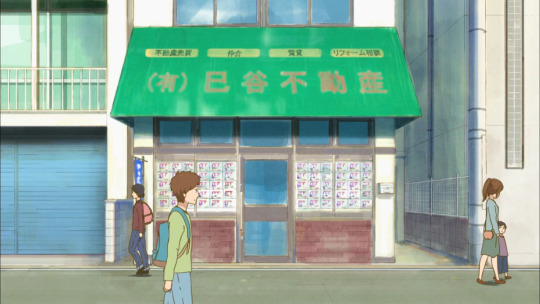
The 巳 (mi) kanji here is the one for snake, in a zodiac sense (normally snake is 蛇 (hebi).
As you could probably guess, this is a realtor's office. When trying to rent a new place in Japan, you are almost certainly going to go one of these offices (they’re extremely recognizable due to the dozens of floor plans plastered out front). Nowadays there are online databases you can use to look up vacant properties, but the posts are by individual realtors so even if you find a place online you’ll still need to go through them—it’s basically impossible to deal directly with the property owner or the property management company.
Also there’s nothing stopping owners from denying a contract to potential renters for being foreign, which can make finding a place a bit more of a hassle if you aren't Japanese. You’ll be at the realtor's office and pick a place you like to go look at, and they’ll have to call up the management company, who will call up the property owner, and ask if “foreigners from [your country] are okay” before moving forward with anything.

Specifically he says 3LDK, which is three bedrooms, a living room, a dining room, and a kitchen. That’s the usual format for describing apartments/condos; 1K is one room plus a kitchen, 2DK is two plus dining and kitchen, etc. In the city, by far the most common type is 1K. Japan doesn't have much of a tradition of having roommates (unless you’re in a dorm of some sort), so most places are either for a single person or a family.
It can actually be pretty hard to find a place that will rent to 2+ people if they aren't married/family, presumably due to some combination of risk aversion (if you and your roommate(s) have a falling out you’re more likely to move out, I guess) and “tradition.” Not to say you can’t, of course, but it definitely adds another layer of difficulty.
irl it would have been impossible for them to find a new place to rent without proper ID for Tohru and Kannaーaside from tourists people on short-term business trips, everyone in Japan must be registered with their local government, and you need proof that you are in order to do anything like renting or opening a bank account.
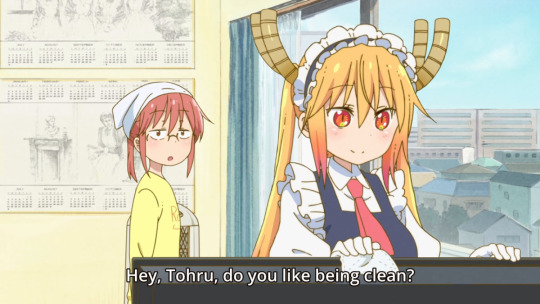
What she actually asks is whether Tohru is kireizuki (綺麗好き), which is a common term for someone who likes to keep things clean—like their room, office, desk, etc., not just personal hygiene.
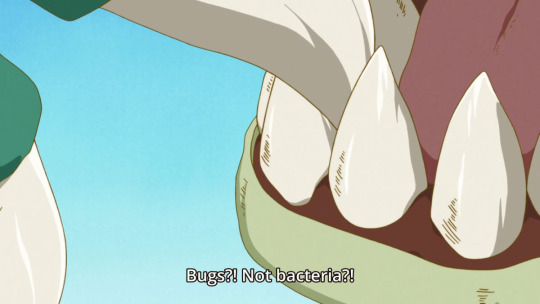
The pun here is that bugs are mushi (虫) and cavities (and the bacteria that cause them) are mushiba/mushibakin (虫歯/虫歯菌). Kobayashi’s line was like “mushi? Not mushibakin?”

Kani (蟹) is crab, in case that wasn't clear. Kani Beer (bi-ru) sounds very similar to Kanibiru, which is a type of parasite that afflicts crabs. If you google image search カニビル you can see some gross pictures of it.
The other bottles there are energy drinks, which in Japan tend to be sold in those tiny bottles and are associated with (and highly marketed to) the huge masses of overworked salarymen.
“Salaryman” (サラリーマン) is by the way a loan word that is used to refer to both male and female salaried office workers.

Titles include such hits as “The World and Life of an English Maid”, “Leave it to Maid!” (volumes 5, 6, and 9), ”Encyclopedia of Maid Wear ”, “Maids and Butlers”, etc.

There’s that “choro-gon” thing again. This scene is a perfect example of the concept: A: “You need to clean up after yourself better!” B: “But I like having you clean up after me…” A: “Oh you! I guess it’s fine then!”
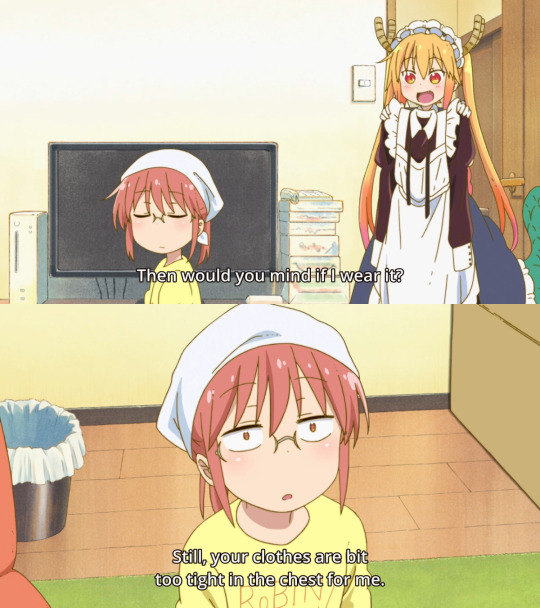
And this is a perfect example of an “oyakusoku.” The instant Tohru asks to try on Kobayashi’s clothes, the audience knows there is a “the chest is a little tight…” joke coming up.

Random fact: Japanese cup sizes go A→B→C→D→E, not AA→A→B→C→D→DD.

Did you know that haiku aren’t just the 5-7-5 thing, but in Japanese they also specifically include “season words” (季語 kigo), that associate them with a particular season? A 5-7-5 poem without them is called a senryuu (川柳) instead. (It’s more complicated than that but, close enough.)
These “season words” are commonly used in other pieces of art as well, as symbols to show what season it is and to evoke certain sentiments.
The “first cherry blossoms” (初桜 or 初花) is what’s being referenced here. Cherry blossoms hold a lot of emotional weight in Japan, and symbolize, among other things, getting a fresh start. The Japanese school year ends in March and begins in April—the period when cherry blossoms bloom—so it’s seen as a time where you’re moving on to new things: new class, new school, new job (college students will have typically secured employment by graduation and start almost immediately), etc., even more so than spring is in other countries on a different schedule.
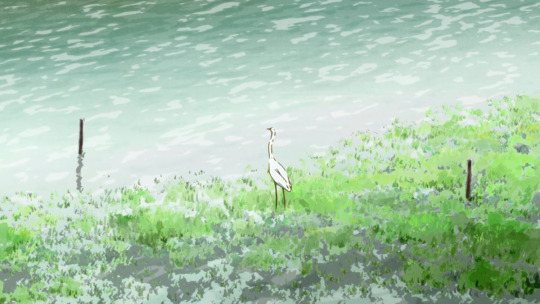
This crane is another spring “season word,” as they return from their winter migration around March. It’s considered a happy event, as they’re finally returning home after a strenuous journey.
Hm? Migratory birds you say?
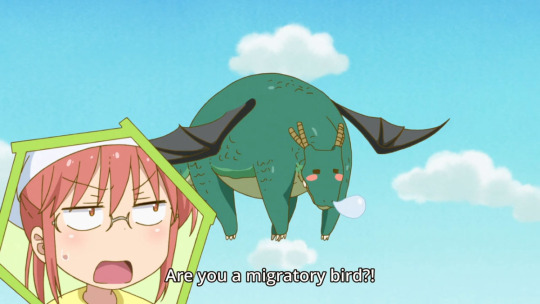
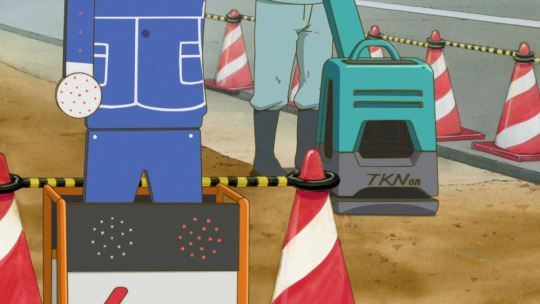
There’s construction going on all the time in Japan. In large part that’s due to infrastructure spending traditionally being a primary source of economic stimulus by the government. Generally they’re very fast about it at least; road work is often done overnight, and new buildings pop up seemingly out of nowhere (at least in Tokyo).
The little cut-out worker dude you see in the foreground there is a real thing that gets used sometimes; often it’s shown bowing and apologizing for the trouble the construction is causing for traffic and such.

Raise your hand if you thought this meant Kobayashi was asking Tohru to hide her horns.
Well, sort of. She actually is using an idiom that means “to make things worse” (角を立てる kado wo tateru). It comes from another phrase, to make (raise the) corners in one’s eyes (目に角を立てる me ni kado wo tateru), which means glaring angrily. Basically the idea is that if you’re “rising corners” (in people’s eyes) you’re making them angry, i.e. making things worse.
Part of the joke though, is that the kanji for “corner” (角 kado) is also the kanji for “horn” (角 tsuno or sometimes kaku).
I'm not sure if the translator was just working off a script and so didn't realize she was saying kado, didn't know the idiom, or was just doing their best to make the line make sense while preserving the horn pun without a paragraph-long TL note.
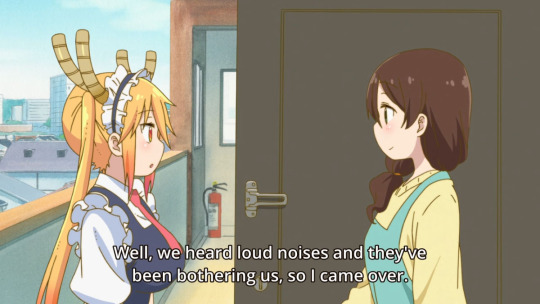
The way she says “bothering” (気になる ki ni naru) here is less rude/direct sounding than in English, and could just as well be read as indicating curiosity or worry as annoyance.
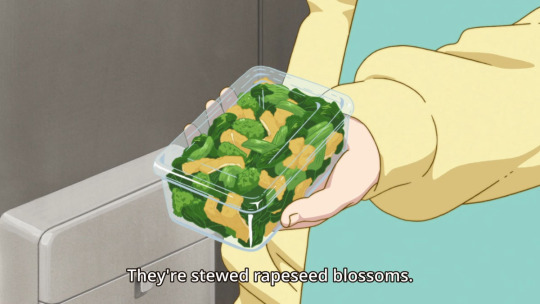
The brown bits are (probably) fried tofu.
Nanohana (菜の花) gets translated as rapeseed a lot, but really it refers to a variety of plants: flowering, edible members of the brassica genus (broccoli, cauliflower, kale, diakon, cabbage, etc.). The one most commonly referred to as “nanohana” is indeed rapeseed, but the kind you eat (i.e. buy at a grocery store in Japan) is a differently cultivated version from the kind you look at as a pretty flower, and more closely resembles tenderstem broccoli.
Nanohana is also...another spring “season word”!

“The one who calls people stupid is the real stupid one” (馬鹿と言う方が馬鹿 baka to iu hou ga baka) is a common saying in Japanese, this is supposed to be a humorous twist on that.
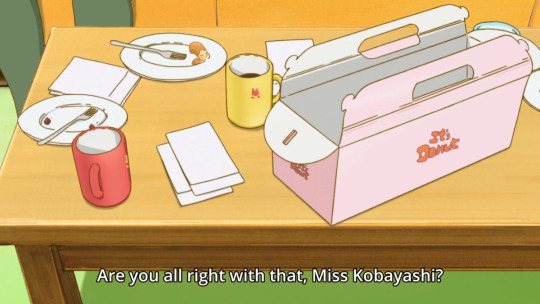
It’s Donut!
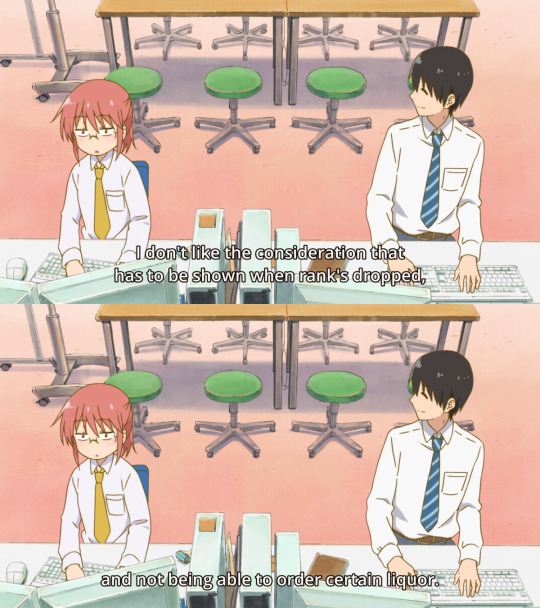
The word for “dropping rank” here is 無礼講 (bureikou). Japanese workplaces are very hierarchical, there’s certain language you have to use with your boss and senpai, it’s very stiff and ritualized in a lot of ways. That can cause problems, especially in the past when it was even stricter, as it highly limits the things you can talk to your superiors about.
The “solution” to this is having a (drinking) party where everyone agrees to drop the act and just have fun/speak your mind. They’re considered important team-building exercises, in a way. However, of course you still can’t take things too far and there are various other social rules involved, so these events have their own difficulties as well.
Kobayashi in particular doesn't seem to like dealing with people, and prefers to hide behind social formalities, as we see later in the episode.
The other phrase here 選べない酒 (erabenai sake; alcohol you can’t choose), I believe is referring to how you can’t turn down drinks when offered at these things. If your boss or senpai is like, “hey, have a drink!” you’re not supposed to refuse—one of the “wait but I thought we dropped the rules” rules.
They actually had to make it a law that you can’t force your subordinates to drink it was such a problem (people getting sick/dying from alcohol poisoning etc.), though I’m not sure how effective it has been.

The phrase she uses here (不安しかないな fuan shika nai na) has more a nuance of “I have a terrible feeling about this,” and I feel the “I'm only worried” translation maybe sort of implies “It’s fine I'm just worried about it is all” instead.
I like the symbolism of Kanna's band snapping as she says it too.

“Goth-loli” is a fashion style, short for gothic lolita, and is not necessarily related to other usages of that word.

Here’s her hiding behind those social formalities. Basically she’s taking the standard formalized template of “how to politely greet someone for the first time (in a work environment)” and just acting it out, rather than actually interacting on a personal level.
The phrase used, 社交辞令 (shakou jirei) refers to these sorts of formalized, “for politeness’s sake” types of things; typically greetings or compliments. It’s kind of like “How are you?” in English, where we ask but don’t actually want or expect a full answer about how they are actually doing or feeling right now—just on a larger scale.
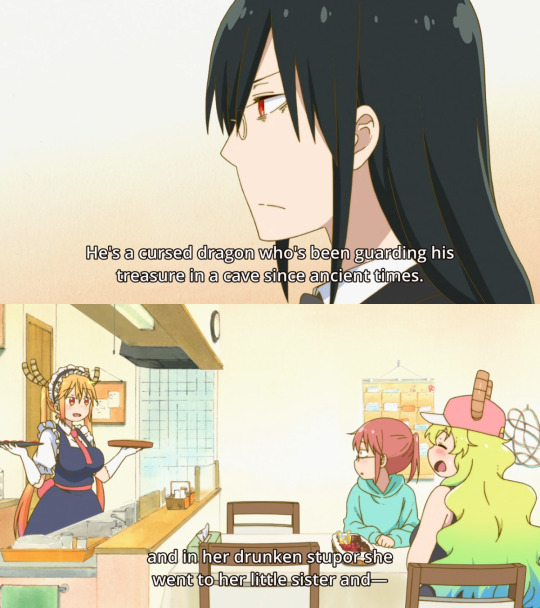
Both Fafnir and Quetzalcoatl have a bunch of references to their mythological counterparts, but you can look that up on Wikipedia just as easily as I can.

“Pai” is used in various words for breasts, so the pi symbol π is used sometimes to refer to them as well. The other word in the background there is 怪しからん (keshikaran), which basically means outrageous/inexcusable. It’s kind of old fashioned, except it’s been turned into a meme where people will use it ironically to describe something erotic and then ask for more. Like, “What are they doing, this is outrageous! No no, don’t stop them.”

The word used here is 痴女 (chijo). It actually means “female pervert,” not necessarily slutty. By “pervert,” it’s meant in like the train molester or flasher kind of way. You may have heard the word used for the train molesters before: chikan (痴漢). Chijo is the female equivalent, literally just replacing the (old fashioned) "man" kanji with the one for woman.
Basically she’s saying “that’s indecent exposure.”
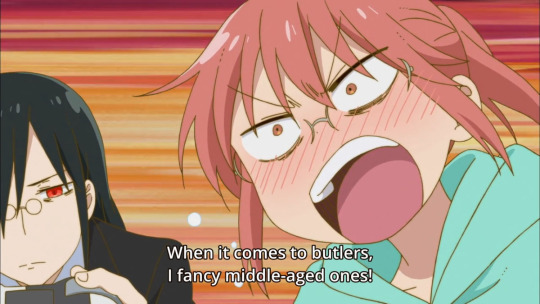
She actually says “early elderly” (初老 shorou), not middle-aged (中年 chuunen). Chuunen is usually from about 40, while shorou is like 60ish. The image is like, white hair, moustache, old-but-still-in-good-shape. Basically Alfred from Batman.
Technically one of the dictionary definitions of shorou is “40,” which would be middle-aged, but that’s not what someone means when they use it in conversation.

In case anyone missed it, she’s just observing that they lean into the turns and such, as some people will tend to do when playing racing games and such.
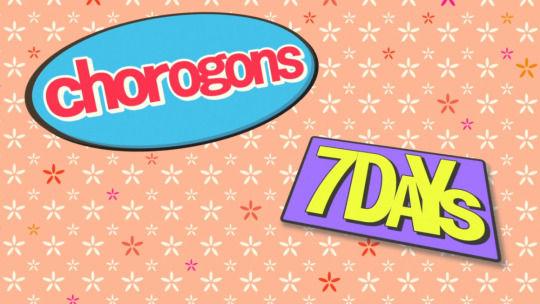
The title of the ED is “Ishukan Communication” (in katakana). 一週間 (isshuukan) means “one week”/”one week’s time,” and you can see all the days of the week references and such. However, ishu (異種) means different species and kan (間) can be used as a suffix similar to the prefix “inter” in English, so it also means “interspecies communication.”
Also: chorogons.
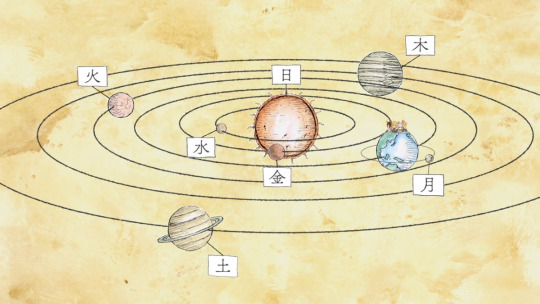
Japanese days of the week are:
月曜日, moon day, named after the moon (月) 火曜日, fire day, named after Mars (火星, fire planet) 水曜日, water day, named after Mercury (水星, water planet) 木曜日, wood day, named after Jupiter (木製, wood planet) 金曜日, gold day, named after Venus (金星, gold planet) 土曜日, groud/soil day, named after Saturn (土星, ground/soil planet) 日曜日, Sunday(!), named after the sun (日)
60 notes
·
View notes
Text
Is Whole Foods Killing You With Canola Oil?
Why do more than 50% of the packaged foods and prepared foods sold at Wholefoods contain canola oil? The answer is not Amazon! Fact, most Wholefood 365 brand has canola in it. Did you know that there is no such thing as a “Canola” plant? Olive oil comes from olives, grapeseed oil comes from grape seeds, peanut oil comes from peanuts, and Canola oil comes from… rapeseed. What’s wrong with this picture? Many food markets like wholefood are selling Canola oil as the “healthy” alternative, but Canola oil is nothing more than “bastardized” oil made from genetically modified rapeseed plants. The problem was that “rapeseed oil” was so toxic that the FDA banned it for human consumption in 1956.
That right, Rapeseed oil was banned from foods because it attacks the heart and causes permanent degenerative lesions. It was originally developed to be an industrial lubricant for fuel, soap, and synthetic rubber base. Rapeseed is the most toxic of all food-oil plants. Even insects won’t eat it! Canola oil is naturally an effective insecticide, and it is the primary ingredient in many “organic” (non-chemical) pesticide control products sprayed on vegetables to kill bugs.
Studies of Canola oil done on rats indicate many problems, such as developing fatty degeneration of heart, kidney, adrenals, and thyroid gland. When the Canola oil was withdrawn from their diet, the deposits dissolved, but scar tissue remained on the organs. The problem is why were no studies done on humans before the FDA placed it on the Generally recognized as safe list ( GRAS) and considered safe by experts.
Canola oil depresses the immune system and causes it to “go to sleep.” Canola oil is high in glycosides which cause health problems by blocking enzyme function, and its effects are cumulative, taking years to show up. One possible effect of long-term use is the destruction of the protective coating surrounding nerves called the myelin sheath. When this protective sheath is gone, our nerves short-circuit causing erratic, uncontrollable movements.
So Why is Wholefood selling food made with canola? The answer is mo money, mo money, mo money! Wholefoods are cashing in on the deregulation of the banned trans oils AKA canola in a big way. 5 years ago packaged food bake food prepared food contained almost no canola oil. Today canola is in every food item imaginable. It is a toxic cheap oil made for pennies on a dollar with little regards for health and with the FDA rubber stamp of Approval its Wholefoods new cash COW!
In closing Whole Foods could easily replace the Canola oil they use in nearly everything they make and sell with 100% Organic Virgin Olive Oil instead, which is far healthier for everyone. But the fact of the matter is, there is just is too much money and too much greed to stop the gravy train from HELL!
from radiantalchemy https://www.radiantalchemy.org/single-post/2018/09/19/Is-Whole-Foods-Killing-You-With-Canola-Oil via https://www.radiantalchemy.org/blog
0 notes
Text
Crop Protection Chemicals Market Study by Key Manufacturers, Regions, Type and Application to 2022
The demand for crop protection chemicals has shown a significant growth owing to rising concerns regarding reduction of the farm coupled with global population growth. The global crop protection market is expected to expand owing to rising concerns regarding the evolution of the nematodes, harmful bugs and the other weed species impacting the natural growth of crop. Worldwide growth in usage of rapeseed with low fat content is expected to augment the demand for crop protection across the global markets.
Browse Detail Market Report @ https://www.millioninsights.com/industry-reports/crop-protection-chemicals-market
These chemicals are used for elimination of unwanted weeds and harmful pests impacting the growth of crops. In addition, development of new products has controlled the attack of certain bugs and fungi thus leading to the growth of insecticides and fungicides market. Increased utilization of fungicides, insecticides, and herbicides for elimination of unwanted elements affecting the growth as well as nutritional value of crops is expected to augment the market growth. The oilseeds type and grain type crops are effectively treated through these chemicals leading to increase in its nutritional value.
Furthermore, rising global population with increasing awareness regarding the food and health safety is expected to boost the market growth. Increasing consumer awareness regarding the environmental concerns and food safety is leading to demand shift for Bio pesticides. In addition, rising rejection of certain pesticides such as atrazine, chlorpyrifos and glyphosate is expected to augment the demand growth for biopesticides in the market.
Biopesticides are derivatives of animals, bacteria, plants and certain minerals which lead to pest control by certain nontoxic mechanisms. Furthermore, the high efficiency of the biopesticides in term of volume requirements per hectare of land is expected to fuel the demand growth in the market over the next eight years.
Stringent regulations against the use of synthetic pesticides due to detrimental environmental impacts are anticipated to hamper the growth of chemical market. The major regulatory bodies across the globe which includes European Commission and U.S. EPA that regulate majority of the product use in the market.
Request Sample Copy to know More About Market Research @ https://www.millioninsights.com/industry-reports/crop-protection-chemicals-market/request-sample
The global crop protection chemical market has been segmented by the product into herbicides, fungicides, insecticides and others. Herbicides market segment accounts for the largest share in terms of volume owing to wide usage in the Europe and North America.
Fungicides account for the significant share in terms of volume in the global markets. The regions with favorable climatic conditions augments the fungal growth which in turn drives the demand. Fungicides are classified as protectants and eradicants. Protectants prevent the growth of fungus in plants; whereas eradicants eliminate the fungal growth. Protectants are the most widely used fungicides in the global markets.
The crop protection chemicals have also been segmented on the basis application including fruits and vegetables, cereals, maize, cotton, rice and others. Cotton is expected to account for the largest share in the global markets owing to increased production coupled with increased utilization of agrochemicals in the cotton yield. Severe drought conditions in the economies such as India have impacted the crop plantation. However, rising government support with several initiatives and monetary aids is anticipated to drive the demand growth in the market. This trend is expected to continue owing to increasing demand for healthier products by the ever increasing population.
The global crop protection chemical market has been segmented on the basis of geography into North America, South & Central America, Europe, Middle East & Africa and Asia Pacific. North America accounts for the largest share of global crop protection chemical market in terms of volume. Ill effects of synthetic chemicals in the North American region are expected to restrain the growth. However, the development of bio pesticides in the region owing to several attributes such as high effectiveness and safety coupled with low toxicity is expected to drive the market growth over the forecast period. In addition, the arable land in the economies of region such as India, China and Southeast Asia has shown a sizeable decrease which is expected to fuel the growth of protection chemical market in the next eight years.
The global key players in the crop protection chemicals market are BASF SE, Arysta LifeScience, Bayer CropScience, American Vanguard, Marrone Bio Innovations, Bioworks, Isagro SpA, Chemutra Corp, Chr Hansen, DuPont, Dow Agrosciences, FMC Corp, Ishihara Sangyo Kaisha, Makhteshim Agan, Natural Industries, Mosanto, Marrone Bio Innovations, NovoZymes A/S, Syngenta AG, Nufarm Ltd, Valent Biosciences and Sumitomo Chemical.In the year 2017, The German Chemical Company BASF SE has partnered with PI industries to work on crop protection solutions. According to the agreement PI Industries is expected to market the innovative technologies of the German company in the Indian market.
0 notes
Note
Isn't supporting bee keepers by buying honey kind of a good thing? Like its a double edged sword bc we shouldn't use animals as food and all but right now with the changing climate and GMO crops and colony collapse disorder it's killing off bees and we desperately need them, so isn't it a good thing that bee keepers are keeping bees alive?
Hi there pretty-love-ly!
We’ve been tricked into believing that honey is simply a byproduct of the essential pollination provided by farmed honeybees. Did you know though that the honeybee’s wild counterparts (such as bumblebees, carpenter and digger bees) are much better pollinators? They are also less likely than farmed honeybees to be affected by mites and Africanized bees. The issue is that these native bees can hibernate for up to 11 months out of the year and do not live in large colonies. Thus, they do not produce massive amounts of honey for a $157 million dollar a year industry.
Honey and the Different Types of Bees
Honey bees: Honey bees make a large quantity of honey (possible due to the size of colonies – that is, many worker bees collecting nectar). Honey consists of nectar combined with a ‘bee enzyme’ that goes through a process of concentration in the honeycomb before it is capped by the bees.
Bumblebees: Bumblebees, in one sense, make a form of honey, which they collect in nectar pots to be eaten by the colony, including the newly hatched worker females. However, the process of concentrating, capping, and the making of honey combs does not happen in bumblebee colonies, nor is nectar stored over winter, since only the queen survives and hibernates, whilst the rest of the colony do not.
Solitary bees: Solitary bees do not make honeycombs. They construct egg cells which they provision with a ball of nectar and pollen that will be consumed by the new larvae.
Honey bees will pollinate many plant species that are not native to their natural habitat but are often inefficient pollinators of such plants.
The crops that can be only pollinated by honey bees are:
• Guar Bean• Quince• Lemon• Lime• Karite• Tamarind
The crops that are pollinated by bees, in general, are:
• Apples• Mangos• Rambutan• Kiwi Fruit• Plums• Peaches• Nectarines• Guava• Rose Hips• Pomegranites• Pears• Black and Red Currants• Alfalfa• Okra• Strawberries• Onions• Cashews• Cactus• Prickly Pear• Apricots• Allspice• Avocados• Passion Fruit• Lima Beans• Kidney Beans• Adzuki Beans• Green Beans• Orchid Plants• Custard Apples• Cherries• Celery• Coffee• Walnut• Cotton• Lychee• Flax• Acerola – used in Vitamin C supplements• Macadamia Nuts• Sunflower Oil• Goa beans• Lemons• Buckwheat• Figs• Fennel• Limes• Quince• Carrots• Persimmons• Palm Oil• Loquat• Durian• Cucumber• Hazelnut• Cantaloupe• Tangelos• Coriander• Caraway• Chestnut• Watermelon• Star Apples• Coconut• Tangerines• Boysenberries• Starfruit• Brazil Nuts• Beets• Mustard Seed• Rapeseed• Broccoli• Cauliflower• Cabbage• Brussels Sprouts• Bok Choy (Chinese Cabbage)• Turnips• Congo Beans• Sword beans• Chili peppers, red peppers, bell peppers, green peppers• Papaya• Safflower• Sesame• Eggplant• Raspberries• Elderberries• Blackberries• Clover• Tamarind• Cocoa• Black Eyed Peas• Vanilla• Cranberries• Tomatoes• Grapes
Check this chart to see which type of bees can pollinate those crops.
While you may spread a heaping tablespoon of honey on your morning toast without thinking, creating each drop is no small feat. To make one pound of honey, a colony must visit over two million flowers, flying over 55,000 miles, at up to 15 miles per hour to do so. During a bee’s lifetime, she will only make approximately one teaspoon of honey, which is essential to the hive for times when nectar is scarce, such as during winter. At times, there may be an excess in the hive, but this amount is difficult to determine and large-scale beekeepers often remove all or most of it and replace it with a sugar or corn syrup substitute. Can you imagine someone removing all the fruit juice from your house and replacing it with fruit-flavored soda? It may still give you energy, but eventually, it will probably make you sick.BEES DIE FOR YOUR HONEY
Another thing to think about while you sit by your beeswax candle and contemplate the lives of these little fellows is that bees must consume approximately eight pounds of honey to produce each pound of wax! And the more we take from them (bee pollen, royal jelly, propolis) the harder these creatures must work and the more bees are needed, which isn’t good news for a population that is dwindling.
When you see a jar of honey, you may think of the sweet cartoon hives depicted in childhood stories such as Winnie the Pooh. But most hives are now confined to large boxes (a completely foreign shape to bees) that are jostled and shipped around the country to pollinate crops and produce honey. This is stressful and confusing to the bees’ natural navigation systems. Along the way, bees are lost and killed, and may spread diseases from one infected hive to another. The practice of bee farming often limits the bees’ diet to monoculture crops, introduces large amounts of pesticides into their systems and causes the farmed bees to crowd out the native wild pollinators that may have been otherwise present. Beekeepers (even small-scale backyard beekeepers) will also kill the queens if they feel the hive is in danger of swarming (fleeing their file cabinet shaped homes) or drones* that they deem unnecessary to honey production. * The drones’ main function is to fertilize the queen when needed.
We have got to the point where we mass exploit honeybees as pollinators to fix a problem that should be fixed from the roots and not partially.
“At certain times of the year, three or four trucks carrying beehives rumble along Highway 20 every week. Their destination: California, where the bees are required for pollination services. During my time in California researching dairy farms, I learned about an extraordinary consequence of intensive farming taken to extremes: industrialized pollination - a business that is rapidly expanding as the natural bee population collapses. In certain parts of the world, as a result of industrial farming, there are no longer enough bees to pollinate the crops. Farmers are forced to hire or rent them in”— Farmagedon. The True Cost of Cheap Meat
The Case of the Disappearing Bees
The question of what will happen if bees disappear may not be far from being answered. Over the past couple of years, stories about bees disappearing and Colony Collapse Disorder (CCD) have been popping up in the The New York Times, Star Tribune, Huffington Post, PBS, Discovery News and more. If nothing else wakes us up, perhaps the fact that the disappearance of bees has become front page news will. Scientists are rushing to discover what’s causing this problem before it’s too late and before we lose the important environmental link created by bees.
Thus far, there are three main theories/contributing factors:
Pesticides
Pennsylvania State University published a study in 2010 that found “unprecedented levels” of pesticides in honeybees and hives in the United States. (If it’s in the bees and hives, what do you think is in your honey?) Some of these chemicals are killing bees, and guess what? The EPA knows about it.
“The EPA identifies two specific neonicotinoids, imidacloprid and clothianidin, as highly toxic to bees. Both chemicals cause symptoms in bees such as memory loss, navigation disruption, paralysis, and death.
Both chemicals have been linked to dramatic honeybee deaths and subsequent suspensions of their use in France and Germany. Several European countries have already suspended them. Last year Slovenia and Italy also suspended their use for what they consider a significant risk to honeybee populations.”
– Mother Earth News
This is old news; this story came out in 2009. But has anything changed here? Not as far as I can tell.
Mites and Viruses
With weakened immune systems (stress, inferior food sources, pesticides etc.) bees have become more susceptible to viruses, fungal infections, and mites. Many of these invasive bugs are spread as hives are moved around the country or transferred from country to country.
While there are a number of treatments on the market for the mites, viruses, fungus and other pests that are attacking our colonies, none have solved the problem completely. These treatments can also introduce antibiotics, pesticides and other chemicals into the hives in an attempt to prevent or heal the infection. If these chemicals (often on strips) are not removed from the hive after they lose potency, they can, in fact, help the viruses or mites become resistant to treatment in the future.
Cell phones
This is one of the newest theories on CCD and may need further testing.
“According to a Swiss researcher who recently published a paper on the subject, the electromagnetic waves from mobile phones have a significant impact on the behavior of honeybees and could potentially be harming honeybees around the world.”
“To test the relationship between honeybees and buzzing cell phones, he placed phones inside bee hives and then monitored the bees’ reaction. He found that in the presence of actively communicating cellphones (those not in standby mode), bees produced the sounds known as “worker piping,” which tends to indicate disturbance in a bee colony.”
– ABC News
Cell phones, pesticides and viruses aside, commercial bee farming – whether organic (where bee deaths are fewer, but still occur) or conventional – does not provide bees with the opportunity to live out their normal life cycle. No matter how small the animal, farming is farming. Whether you choose to buy backyard honey or a large brand, eating honey and using other bee products encourages using bees for profit.
If you truly want to save bees as a whole and not only honey bees because is much more convenient.. then support bee sanctuaries, boycott the agribusiness and its use of chemicals everywhere. Here I leave some ideas and ways to help bees.
Sanctuaries
Spikenard Farm Honeybee Sanctuary | • Virginia, USA •
New York Bee Sanctuary | • New York, USA •
Native Bee Sanctuary | • Australia •
Artemis Smiles - Honey Bee Sanctuary | • Hawaii, USA •
Urban Evergreen Bee Sanctuary | • Washington, USA •
The Honeybee Helpers | • North West, Ireland •
Bee Sanctuary - The Bee School | • North Carolina, USA •
Bellingen Bee Sanctuary | • Australia •
Morgan Freeman Converted His 124 Acre Ranch Into A Bee Sanctuary To Help Save The Bees
Plant your garden with bee-friendly plants
In areas of the country where there are few agricultural crops, honeybees rely upon garden flowers to ensure they have a diverse diet and to provide nectar and pollen. Encourage honeybees to visit your garden by planting single flowering plants and vegetables. Go for all the allium family, all the mints, all beans except French beans and flowering herbs. Bees like daisy-shaped flowers - asters and sunflowers, also tall plants like hollyhocks, larkspur and foxgloves. Bees need a lot of pollen and trees are a good source of food. Willows and lime trees are exceptionally good.
Encourage local authorities to use bee-friendly plants in public spaces
Some of the country’s best gardens and open spaces are managed by local authorities. Recently these authorities have recognised the value of planning gardens, roundabouts and other areas with flowers that attract bees. Encourage your authority to improve the area you live in by adventurous planting schemes. These can often be maintained by local residents if the authority feels they do not have sufficient resources.
Weeds can be a good thing
Contrary to popular belief, a lawn full of clover and dandelions is not just a good thing—it’s a great thing! A haven for honeybees (and other native pollinators too). Don’t be so nervous about letting your lawn live a little. Wildflowers, many of which we might classify as weeds, are some of the most important food sources for native North American bees. If some of these are “weeds” you chose to get rid of (say you want to pull out that blackberry bush that’s taking over), let it bloom first for the bees and then before it goes to seed, pull it out or trim it back!
Don’t use chemicals or pesticides to treat your lawn or garden
Yes, they make your lawn look pristine and pretty, but they’re actually doing the opposite to the life in your biosphere. The chemicals and pest treatments you put on your lawn and garden can cause damage to the honeybees systems. These treatments are especially damaging if applied while the flowers are in bloom as they will get into the pollen and nectar and be taken back to the bee hive where they also get into the honey—which in turn means they can get into us. Pesticides, specifically neo-nicotinoid varieties have been one of the major culprits in Colony Collapse Disorder.
Bees are thirsty. Put a small basin of fresh water outside your home
You may not have known this one—but it’s easy and it’s true! If you have a lot of bees starting to come to your new garden of native plants, wildflowers, and flowering herbs, put a little water basin out (a bird bath with some stones in it for them to crawl on does a nice trick). They will appreciate it!
Let dandelions and clover grow in your yard.
Dandelions and clover are two of the bees’ favorite foods – they provide tons of nourishment and pollen for our pollinators to make honey and to feed their young (look at this bee frolicking in a dandelion below – like a pig in shit!) And these flowers could not be any easier to grow – all you have to do is not do anything.
I highly recommend also taking a look at this article too as honey is tested on animals, yes, as it says and the article explains honey is tested on dogs, cats, goats, rabbits, mice, rats…
As you can see, there is much more than saying “let’s help the bees by eating honey, vegans are dumb, they need to eat honey because what they eat relies on it”... We can save the bees without taking away the honey they produce, that’s a fact.
Honey is meant as a health food; a healthy food for bees. The more we interfere with their natural processes, both by relying on farmed bees as pollinators (rather than other native wild bees, insects or animals) and to feed our desires for “sweets,” the close we’re coming to agricultural disaster.
Sources
1. Danforth BN, Sipes S, Fang J, Brady SG (October 2006). “The history of early bee diversification based on five genes plus morphology”. Proc. Natl. Acad. Sci. U.S.A. 103 (41): 15118–23.2. Pollinators’ impact on crop production Research study in Proceedings of the Royal Society B: Biological Sciences of 25 October 2006.3. Pollination and Bee Plants, Excerpted from Beekeeper’s Handbook, Sammataro/Avitabile ©1998.4. Bryony, Bonning (11 November 2009). “Honey Bee Disease Overview” (PDF). Journal of Invertebrate Pathology 103: s2-s4. doi:10.1016/j.jip.2009.07.015. Retrieved 21 October 2014.5. “Bumblebee Specialist Group: 2011 Update” (PDF). IUCN. Retrieved7 October 2012.6. Yang, Sarah (25 October 2006). “Pollinators help one-third of world’s crop production, says new study”. UC Berkeley. Retrieved 29 June 2015.
982 notes
·
View notes
Photo

Just got back from a trip to Scotland. After a crappy first night the next 2 nights were pretty good (which was lucky because on the 3rd night I had a vomiting bug 🙄 AGAIN). Anyway, may be clutching at straws but we couldn't get hemp milk so we gave oat milk - not the foamable one dietitian recommended as they didn't have it but the plain one so we are going to carry on with that. The foamable one has rapeseed oil in (as does the dairy free vitalite he has). So I've also found an alternative Marge as he has that most days too (but not whilst we were away). Meanwhile my stomach is still churning crazily (this did not make for a pleasant flight home let me tell you - I was still vomiting an hour before we left). Just fingers crossed it doesn't spread to the boys now 🙏 On the plus side we managed our first flight and boys behaved well and seemed none the worse for it. Hubby found lugging car seats on a trolley a bit stressful but hey you've got to allow for a little more difficulty when travelling with kids right?! Child in front of us (aged 3) was kicking off big time so I was just glad that wasn't us!!
0 notes